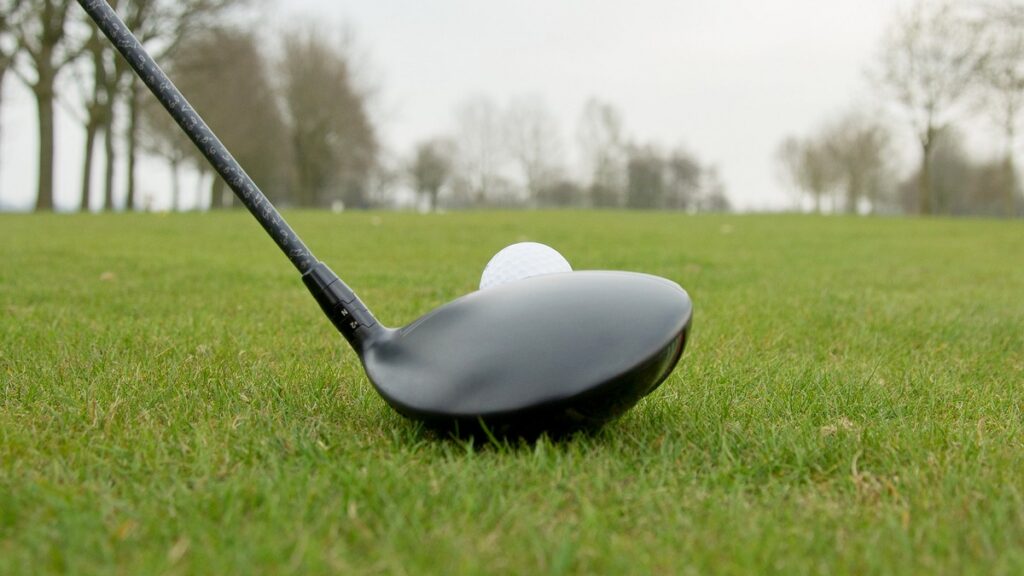Adam Scott Swing Sequence
He’s one of the hottest properties in sport and one of the finest role-models in golf today. The current world No. 8 Adam Scott also happens to own perhaps the most enviable swing in the world. Six-time major champion and Gi professional Sir Nick Faldo certainly thinks so, and in this exclusive analysis he draws out the key elements in the Australian’s technique that can help you to go out and improve yours
A WINNING COMBINATION – ‘Sequencing’ of movement is his key
Playing this game for a living was a heck of a lifestyle but in ‘retirement’ I may have found an even better number. In my role as analyst for CBS television I get paid to sit and watch the best players in the world, a privileged and fascinating experience given the talent on tour these days. And if someone were to ask me who currently has the best swing in golf I would not hesitate in nominating Australia’s Adam Scott.
Adam Scott Swing Sequence
There simply isn’t a flaw in the motion you see here. This is as good as it gets. In fact, looking at these images I’m reminded of the classic on-air advice from the producer: ‘If you cannot better the picture, there’s no need to say anything!’ Fortunately, magazines are a little different and so I’m going to take this opportunity to talk you through Adam’s swing from two angles (face-on here, down-the-line over the page) and at the same time try to help you identify with the key areas those of you young enough and supple enough should try to copy.
First up, just look at the quality of Adam’s body lines and angles. The posture lines are terrific, his alignment of feet, knees, hips and shoulders all agree, the proportions perfect. A model set-up to a model golf swing.
One thing I know Adam has worked on this year is keeping the clubhead square in the first move away from the ball. For a while there he had a little too much rotation and the clubface was open a fraction; here it looks just right. The clubface is square to the path as the arms and the shoulders control this initial sequence.
Stop a moment to study the relationship between the arms as Adam works from the setup through frame 4; the left arm rotates while the right elbow folds gently, all the time working in harmony with the rotation of the torso (overleaf, in the equivalent position to frame 4 here, you will see how the hands are directly in line with the sternum at this point).
Adam is not a player who likes to ‘set’ the club (or the wrists) early in the backswing; he fully sets when he gets to the top. Of course, the angle in the wrists is steadily increasing and he times it all so perfectly, so that the maximum ‘set’ coincides with the full extent of his backswing rotation. My style, notably so during the swing change in the mid-1980s was to ‘set’ the wrists much earlier (an antidote to my old tendency of dragging the hands back). This is an area you, as an individual, must work on and experiment with to discover which ‘feel’ works best.
The critical gearing of body movement Studying the movement to the top of the swing you appreciate just how beautifully Adam engineers the coiling motion. And this is typical of the young generation today – these guys are strong, they work out to develop their core muscle. This is where golf at the highest level is going. But no one in the game can beat Adam Scott for the sheer quality of the motion.
For me, it’s the quality of the ratio of turn between knee, hips and belly-button. Focus on that when you practice and you can dramatically improve the quality of your coiling motion, the torque you achieve. It’s a ‘1, 2, 3’ – i.e. the knees rotate less than the hips, the hips fractionally less than the belly-button. The reason Adam’s arms work so well has a lot to do with this gearing of the body movement. Study the way he coils his body; nothing moves very far – we’re talking a matter of inches – but it is this sequencing that matters. Get it out of sync and you lose the essential gearing that gives you the torque.
As a result of his core winding and unwinding so efficiently, Adam has the green light to fire his belly through with what you might term a ‘body spring’. Power is generated by that core motion. The delivery of the clubhead is perfect – a little on the up to give him the desired trajectory (on the high side but a shot that tips over nicely).
Adam Scott Swing Sequence
There is no strain to this – that’s another characteristic of this swing. And he has the most fantastic arm speed of all of the great young players on tour. I’ve said this on TV several times – I’d like to measure his arm-speed as I think he is the fastest out there. They really whip through. Basically, his body is moving so well it just looks like he is swinging the arms and he signs it all off with that trademark full wrap, the club all the way around the back of his neck. Finally, a word of advice on the all-important action of releasing the clubhead through impact.
World-class players like Adam don’t see impact as being at the ball, they visualise the impact area as a zone extending a couple of feet or so either side of the ball. It’s then all about finding this ‘slot’. Try to visualise a rail and put the club onto that rail and let it slot through the ball – that will help to free you up in the only area that really matters.
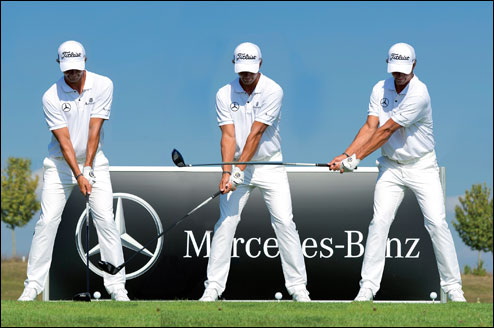
Adam Scott Swing Sequence
Textbook structure, insides of the feet shoulder-width for stability with the driver, hands and arms beautifully ‘in sync’ with the body
Left shoulder works down and left arm begins its rotation – smooth and subtle moves to initiate momentum
Left arm works across the chest as right arm softens and folds – note the clubface is square to the path
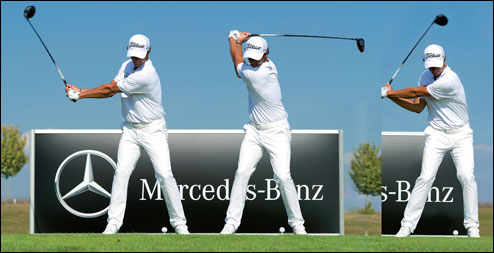
Adam Scott Swing Sequence
Like many strong young players today, Adam likes to delay the full setting of the wrists…it’s increasing… 60%…70%…
….and now 100%. Full wrist set timed perfectly with the rotation of the upper body
Love the position of the right elbow here, increasing the lag as he approaches the hitting area.
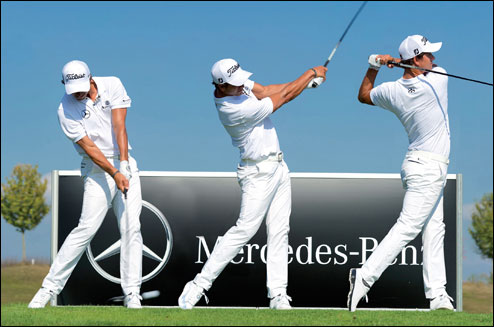
Adam Scott Swing Sequence
Head remains perfectly still behind the ball as he lets it all go – to focus on a precise dimple or dot on back of the ball is a great way of achieving this
Rotation of the right shoulder continues all the way through the hitting area – a sense of ‘chasing’ after the ball
Balance on the toe, knees kissing, great angles and the clubshaft in a full wrap
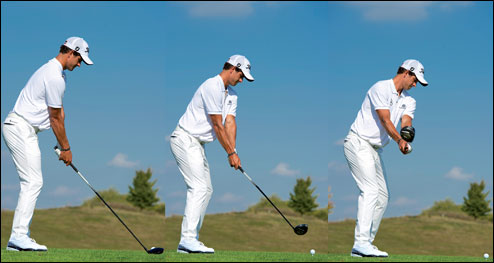
Adam Scott Swing Sequence
With his weight balanced on the balls of the feet Adam is able to create perfect angles. Feet, knees, hips and shoulders all parallel to the target line
Knees holding, hips just barely moving, belly on its way – in establishing this gearing ratio, Adam is on track to create tremendous torque
Clubface in a great position as the shaft parallels the feet
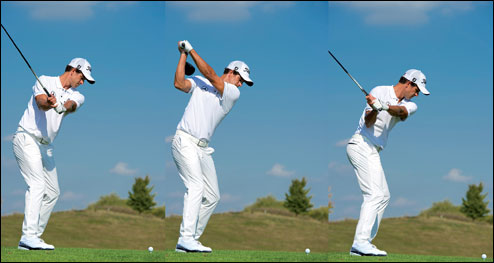
Adam Scott Swing Sequence
As wrists hinge up the clubshaft bisects the right shoulder – a simple checkpoint to keep your swing on plane
To all of you who suffer a tendency to ‘trap’ the right elbow look at the way Adam allows his to work freely (as he starts down it then falls nicely back in towards the body)
A ‘quiet’ body through the transition as Adam settles into the downswing, the arms shallowing into a terrific hitting position
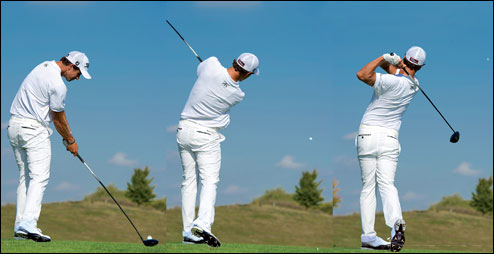
Adam Scott Swing Sequence
Arms and torso working together through impact – body angles still excellent as he rotates at speed
Sensation here is one of throwing the arms and the clubhead freely all the way to the finish
Think about putting the shaft at this angle across your neck at the finish. And, guess what folks, you’ll find a way of getting there
Originally posted in 2012
